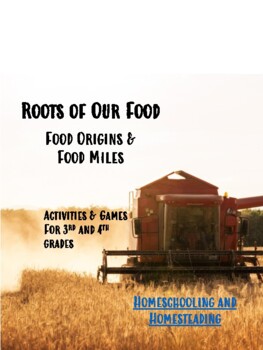Food Origins, Nutrition, Farm-to-Table Activities and Games
Homeschooling and Homesteading
172 Followers
Grade Levels
3rd - 4th, Homeschool
Subjects
Resource Type
Standards
CCSS3.MD.A.2
CCSS3.MD.B.4
CCSS4.MD.A.2
CCSS3.NF.A.1
CCSS3.NF.A.3
Formats Included
- PDF
- Easel Activity
Pages
21 pages
Homeschooling and Homesteading
172 Followers
Easel Activity Included
This resource includes a ready-to-use interactive activity students can complete on any device. Easel by TPT is free to use! Learn more.
Description
This collection was designed to empower students to make their own decisions regarding their nutrition, health, diet, and their impact on the environment.
A comprehensive list of materials needed and detailed directions are included in this packet. Each experience can be split into its own lesson.
Where does our food come from? It traveled to the grocery store somehow.
- Students will do a brief study of the parts of plants that we eat to help them understand the origin of their meal.
- Children will use a map and the food in their lunchboxes to figure out the ‘food miles’ their food traveled to get to them.
- Students will learn to make a simple, healthy meal
Related Resources:
Total Pages
21 pages
Answer Key
Included
Teaching Duration
3 hours
Report this resource to TPT
Reported resources will be reviewed by our team. Report this resource to let us know if this resource violates TPT’s content guidelines.
Standards
to see state-specific standards (only available in the US).
CCSS3.MD.A.2
Measure and estimate liquid volumes and masses of objects using standard units of grams (g), kilograms (kg), and liters (l). Add, subtract, multiply, or divide to solve one-step word problems involving masses or volumes that are given in the same units, e.g., by using drawings (such as a beaker with a measurement scale) to represent the problem.
CCSS3.MD.B.4
Generate measurement data by measuring lengths using rulers marked with halves and fourths of an inch. Show the data by making a line plot, where the horizontal scale is marked off in appropriate units-whole numbers, halves, or quarters.
CCSS4.MD.A.2
Use the four operations to solve word problems involving distances, intervals of time, liquid volumes, masses of objects, and money, including problems involving simple fractions or decimals, and problems that require expressing measurements given in a larger unit in terms of a smaller unit. Represent measurement quantities using diagrams such as number line diagrams that feature a measurement scale.
CCSS3.NF.A.1
Understand a fraction 1/𝘣 as the quantity formed by 1 part when a whole is partitioned into 𝘣 equal parts; understand a fraction 𝘢/𝑏 as the quantity formed by 𝘢 parts of size 1/𝘣.
CCSS3.NF.A.3
Explain equivalence of fractions in special cases, and compare fractions by reasoning about their size.




